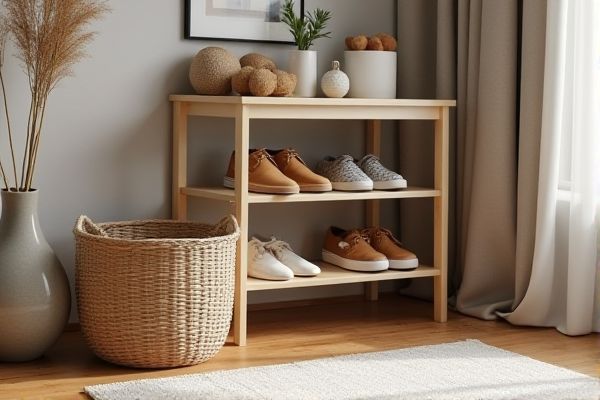
A shoe basket offers a spacious, enclosed design ideal for storing multiple pairs of shoes neatly, while a shoe tray provides an open, flat surface that protects floors from dirt and moisture. Explore the rest of the article to find out which option best suits your storage needs and enhances Your entryway organization.
Table of Comparison
| Feature | Shoe Basket | Shoe Tray |
|---|---|---|
| Purpose | Storage and organization of shoes | Protection of floor from dirt and moisture |
| Design | Open or closed container, often portable | Flat, shallow platform usually placed near entry |
| Material | Plastic, wicker, fabric | Plastic, rubber, metal, silicone |
| Capacity | Multiple pairs, stackable | Limited to few pairs placed side-by-side |
| Maintenance | Can be washed or wiped | Easy to clean, often waterproof |
| Placement | Indoors, closets, rooms | Entryways, door thresholds |
| Functionality | Organizes and stores shoes neatly | Protects floor, keeps area clean |
Introduction to Shoe Baskets and Shoe Trays
Shoe baskets and shoe trays serve as practical solutions for organizing footwear and maintaining cleanliness in your home. Shoe baskets, often made from woven materials or fabric, provide breathable storage that is easy to move and conceal shoes neatly. Shoe trays, usually crafted from plastic or rubber, offer a sturdy, waterproof surface to contain dirt and moisture, keeping floors protected from muddy or wet shoes.
Key Differences Between Shoe Baskets and Shoe Trays
Shoe baskets and shoe trays differ primarily in design, capacity, and organization. Shoe baskets typically offer enclosed storage with ventilation, making them suitable for larger collections and preventing dust buildup, while shoe trays provide an open, flat surface that catches dirt and moisture, ideal for quick access and cleaning. Choosing between the two depends on your space constraints and whether your priority is containment or easy maintenance.
Design and Material Comparison
Shoe baskets are typically made from woven materials like rattan, plastic, or fabric, offering lightweight and breathable storage solutions with a casual aesthetic. Shoe trays often feature sturdy, waterproof materials such as plastic, metal, or silicone, designed to contain dirt and moisture while providing a stable base for wet or muddy shoes. The design of shoe baskets prioritizes ventilation and portability, whereas shoe trays emphasize durability and easy cleaning to protect floors.
Space Efficiency and Storage Capacity
A shoe basket typically offers greater storage capacity due to its taller and enclosed design, accommodating multiple pairs of shoes vertically and protecting them from dust. In contrast, a shoe tray provides superior space efficiency by fitting neatly under furniture or in entryways, often stacking shoes side-by-side without occupying excessive floor area. Choosing between a shoe basket and shoe tray depends on balancing the need for compact storage with the volume of shoes to be organized.
Ease of Cleaning and Maintenance
A shoe basket typically features an open-weave design that allows for easy dust removal and quick airing of shoes, simplifying cleaning and reducing odor buildup. In contrast, a shoe tray's solid base collects dirt and moisture, which requires more frequent wiping and sanitizing to maintain hygiene. Choosing between the two depends on prioritizing either airflow and minimal maintenance (shoe basket) or containment of debris and liquids (shoe tray).
Aesthetic Appeal and Home Decor Considerations
Choosing between a shoe basket and a shoe tray can significantly impact your home's aesthetic appeal and overall decor. A shoe basket offers a cozy, rustic look with its woven textures, seamlessly blending into casual or bohemian interior styles, while a shoe tray provides a sleek, minimalist option perfect for modern, clean-lined spaces. Your choice should reflect your decor preferences and storage needs, enhancing both organization and the visual harmony of your entryway or closet.
Suitability for Different Shoe Types
Shoe baskets are ideal for bulky footwear like boots and high-tops, providing ample space and ventilation to maintain shape and freshness. Shoe trays suit smaller or flat shoes such as sandals, sneakers, and dress shoes by keeping them neatly organized and protecting floors from dirt and moisture. Your choice depends on the shoe type you own, ensuring proper storage and easy access.
Best Use Cases for Shoe Baskets
Shoe baskets excel in organizing your entryway or bedroom by holding multiple pairs of shoes in one convenient container, making them ideal for quick tidying and transport. Unlike shallow shoe trays, baskets offer deeper storage space, perfect for bulky footwear like boots or multiple shoe styles. Their breathable design often allows for airflow, keeping shoes fresh while maintaining a neat, clutter-free environment.
Best Use Cases for Shoe Trays
Shoe trays are ideal for entryways and mudrooms, effectively containing dirt, mud, and water from wet or snowy footwear while protecting floors from damage. Their shallow design supports quick access and organization, making them perfect for everyday use and high-traffic areas. Unlike shoe baskets, trays prioritize functionality over storage capacity, focusing on cleanliness and preventing mess rather than concealing shoes.
Choosing the Right Option for Your Home
Shoe baskets offer a flexible and lightweight storage solution ideal for quick organization and easy transport, while shoe trays provide durable, waterproof protection that keeps floors clean from dirt and moisture. For homes with limited space or frequent shoe changes, baskets allow convenient stacking and mobility, whereas trays are better suited for entryways or mudrooms to contain debris and maintain cleanliness. Selecting the right option depends on your storage needs, available space, and the level of protection required for your flooring surfaces.
 homyna.com
homyna.com